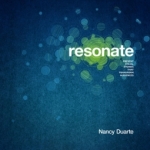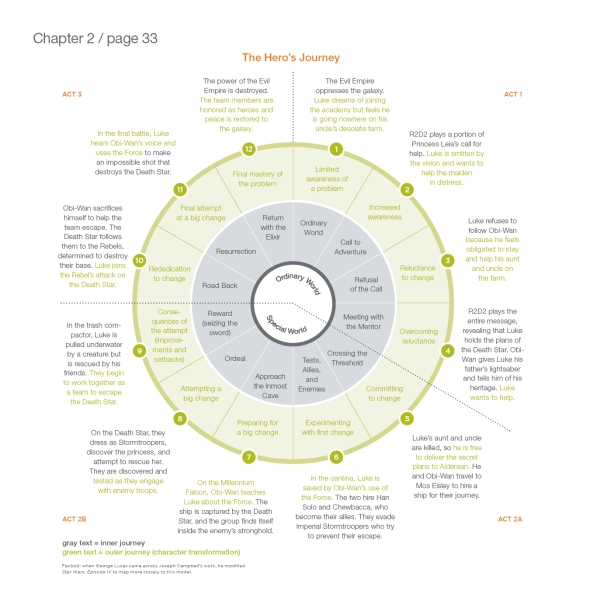The 5 Most Memorable Concepts From Nancy Duarte’s New Book, Resonate
Posted: January 28, 2011 Filed under: Books, Reviews, Uncategorized | Tags: Hero's Journey, Nancy Duarte, presentation advice, Presentation form, process recap, Resonate, story, storytelling, transparent 7 Comments When Nancy Duarte announced her second book, a prequel to her wonderful first book, Slideology, I was excited. But when I heard that it was designed to teach about harnessing the power of stories and storytelling in presentations, I was beside myself. I’ve been a fan of many different art forms for as long as I can remember, and I’ve always been particularly drawn to the storytellers, from Billy Joel and Ben Folds, to Tolkien and Spielberg. But despite the large volume of film, music, and literature I’ve consumed in my life, I’ve never really studied the structure of these stories in any great detail.
When Nancy Duarte announced her second book, a prequel to her wonderful first book, Slideology, I was excited. But when I heard that it was designed to teach about harnessing the power of stories and storytelling in presentations, I was beside myself. I’ve been a fan of many different art forms for as long as I can remember, and I’ve always been particularly drawn to the storytellers, from Billy Joel and Ben Folds, to Tolkien and Spielberg. But despite the large volume of film, music, and literature I’ve consumed in my life, I’ve never really studied the structure of these stories in any great detail.
I purchased the book shortly after it came out about four months ago and during those four months I’ve been poring over it, reading and re-reading the especially good bits. I’ve also enjoyed all the presentations and snapshots of concepts in the book that Duarte themselves have released since then (wade back through Duarte’s blog posts for more). Numerous articles have been written during that time praising the book and Nancy for its clarity and it’s message. I’ve gone back and forth about whether I wanted to write a review. What more could I possibly add to the discussion that hasn’t already been said at this point?
But what I realized is that there are several images and concepts from the book that have stuck in my mind even long after reading them. So, last night, I sat down with a pad of paper and noted the top five things that come to mind as most significant when I think of Resonate, and I’d like to share them with you today.
1. The Hero’s Journey
In Resonate, Nancy introduces a concept I’ve seen time and time again in hundreds and hundreds of films, plays, and books over the years and yet still did not recognize or have a name for: the hero’s journey. Based on the psychology of Carl Jung and the mythology research of Joseph Campbell, the hero’s journey reveals the basic structure of numerous stories, myths, and movies. It’s was amazing to me that I could watch so many movies without coming to an understanding of their structure until it was expressly revealed. I never considered that I might be watching the same story over and over again with different names and faces. This one concept, illustrated below, was remarkably helpful to me and my understanding of how to construct stories. (Click on these images to see them larger.)
[Image source: Duarte.com]
2. The Presentation Form
Equally earth-shaking to me (and thus, memorable) was Nancy’s identification of the shape of a good presentation. Presented as a sparkline, Nancy shows that all good presentations create contrast by comparing what is (the status quo) with what could be, eventually conveying to the audience the idea of what Nancy calls “the new bliss.” A basic diagram of the presentation form is below, and I strongly encourage you to watch Nancy explain the concept herself in this video. How remarkable to now be able to identify a good presentation not only by hearing it, but by sight.
[Image source: Duarte.com]
Unfortunately, I couldn’t find images or examples of most of these last three concepts. They’re so good, though, so I encourage you to find a copy (maybe just sneak into a Barnes and Noble and flip through one…or buy it, it’ll be worth it, I promise) and check them out.
3. Nancy’s Expostion of I Have a Dream and The Gettysburg Address
Nancy uses numerous examples to illustrate how the above form applies to all types of presentations, from scientific lectures to Mozart sonatas. But the examples that stick out most prominently in my mind are when she shows how Dr. Martin Luther King, Jr.’s I Have a Dream speech and Abraham Lincoln’s Gettysburg Address so perfectly illustrate that form. Lincoln’s address is so brief that Nancy was able to lay out all of its text, in the presentation form on one page. All of the elements of a great speech are present, and its simplicity, brevity, and eloquence are even more striking when displayed that way. Likewise, Nancy laid out Dr. King’s speech in the presentation form, thus revealing its remarkable structure as well. You can see a similar rendering of the speech by watching Nancy analyze the speech here (the speech overlaid on the presentation form is first seen around 1:10 in the video). Realizing that these presentations, which are already so beautiful just to hear, are also beautifully constructed and lovely to look at was very powerful and inspiring. It makes me want to learn to construct things of such beauty myself.
4. Process Recap
Slideology, Nancy’s first book, was about creating slides, whereas Resonate is all about how to develop content for your speech. Chapters 5 and 6 detail how to generate ideas, organize those ideas into messages and stories, and then create images to support those stories. But on page 142 of the book, Nancy, in a beautiful, two-page spread, recounts the entire process visually and shows how the whole process can be done with nothing more than a pen and a stack of post-its. Seeing the process laid out this way makes the process of writing a speech and creating a presentation (a task that easily intimidates many people) seem simple and very clear. I wish I had a print of that process recap that I could frame and hang on my wall, that’s how thankful I was to have the whole process delineated so clearly. In my opinion, those two chapters alone are worth the price of the book.
5. Be Transparent
The final chapter of the book, chapter 9, is titled “Change Your World” and is not about how to give a speech, but why. Nancy discusses that all great ideas started out as nothing more than that, an idea, and it was up to the people who had those ideas to communicate them to others in order to see those ideas realized. She also talks about the need to use presentation skills for good and not evil, as was done by Jeff Skilling, Kenneth Lay, and Richard Causey during the Enron scandal. All of this was excellent advice, but the thing that stuck out most to me was Nancy’s exhortation to be transparent in order to let people see through you and see your ideas instead. What an amazing concept! The idea is to construct your presentation in such a way that everything — from the delivery, to the visuals, to your mannerisms on stage — points clearly to your message and doesn’t distract from that message in any way. Nancy then gives three keys to being transparent, but I won’t reveal those here. You’ll have to find a copy of her book.
Resonate is an instant classic of presentation theory and a book I’m sure I’ll refer back to very often as I create presentations in the future. I’ve briefly glossed over the parts of the book that stick out in my mind here, but there’s so much more detail in the book. If you give speeches or lectures or lessons or sermons on a regular basis or even occasionally I strongly encourage you to find a copy and absorb as much of the good advice Nancy has collected as you can.
Moving Mountains
Posted: January 21, 2011 Filed under: Communication, Presenting Tips, Quotes | Tags: boettinger, communication, information design, moving mountains, presenting, public speaking, Resonate, structure 1 Comment“It’s unwise to merely dump a pile of unstructured information into the laps of your audience. They will have the same reaction as if you take a watch apart, fling the pieces at them and say ‘Here’s all you need to make a watch.’ You might get high marks for research and energy, but that is a low-class consolation prize. By doing this you confess that you don’t know what to do with all the stuff you’ve dug up. Audiences expect structure.”
— Henry M. Boettinger
From ‘Moving Mountains: The Art of Letting Others See Things Your Way‘
Discovered in ‘Resonate‘ by Nancy Duarte
I Have A Dream
Posted: January 17, 2011 Filed under: Communication, Good Speeches | Tags: Dr Martin Luther King Jr., I Have A Dream, Martin Luther King Jr., MLK, Nancy Duarte, Resonate 2 Comments Today is the day that our nation pauses each year to remember Dr. Martin Luther King, Jr.’s life and legacy. Dr. King’s “I Have A Dream” speech is one of the most famous speeches in all of history, but have you ever actually listened to it in its entirety? I’m embarrassed to say that I hadn’t until a few months ago when Nancy Duarte used it as an example in her new book, Resonate, and made the video available on Duarte.com. It’s an amazing speech which has the power to stir emotions today, almost fifty years later.
Today is the day that our nation pauses each year to remember Dr. Martin Luther King, Jr.’s life and legacy. Dr. King’s “I Have A Dream” speech is one of the most famous speeches in all of history, but have you ever actually listened to it in its entirety? I’m embarrassed to say that I hadn’t until a few months ago when Nancy Duarte used it as an example in her new book, Resonate, and made the video available on Duarte.com. It’s an amazing speech which has the power to stir emotions today, almost fifty years later.
Recently Nancy published a blog post in which she included a video of Dr. King’s speech in its entirety along with a brief video analysis of the speech’s form and structure. Today, I wish you would spend whatever time you might have spent reading this blog and instead read her post and watch the two videos. Dr. King’s speech is around seventeen minutes long and Nancy’s analysis is seven minutes long, so you should be able to watch both in just around a half an hour. I promise you’ll be glad you did.
Image By Unknown? [Public domain], via Wikimedia Commons






